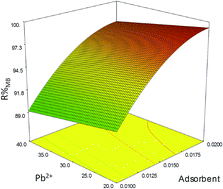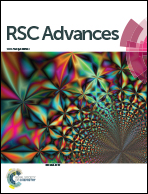Simultaneous removal of methylene blue and Pb2+ ions using ruthenium nanoparticle-loaded activated carbon: response surface methodology
Abstract
Ruthenium nanoparticles were synthesized in a green approach with high yield in the presence of ultrasound and then the product was loaded on activated carbon. Characterization was performed using different techniques such as SEM, XRD, and BET. The simultaneous removal of methylene blue (MB) and Pb2+ ions from aqueous solution by ruthenium nanoparticles loaded on activated carbon (Ru-NPs–AC) was studied. The effects of variables such as initial dye and Pb2+ ion concentrations (mg L−1), adsorbent doses (g) and contact time (min) on the simultaneous removal of MB and Pb2+ ions were studied. Experiments were conducted using central composite design (CCD) and the optimum experimental conditions were found under response surface methodology (RSM). Adsorption equilibrium data were well fitted by the Langmuir isotherm model compared to the Freundlich, Temkin and Dubinin–Radushkevich models. Experimental adsorption data were analyzed using various kinetic models such as pseudo-first and second order, Elovich and intraparticle diffusion models. A good fit to the pseudo-second order model was observed. Dye removal varied from 77% to 99% within the operating conditions considered herein.


 Please wait while we load your content...
Please wait while we load your content...